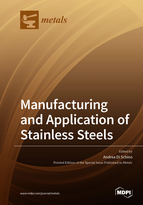Manufacturing and Application of Stainless Steels
A special issue of Metals (ISSN 2075-4701). This special issue belongs to the section "Metal Casting, Forming and Heat Treatment".
Deadline for manuscript submissions: closed (30 November 2019) | Viewed by 86533
Special Issue Editor
Interests: steels; microstructure; properties; additive materials
Special Issues, Collections and Topics in MDPI journals
Special Issue Information
Dear Colleagues,
Stainless steels represent a quite interesting material family, both from a scientific and commercial point of view, following to their excellent combination in terms of strength and ductility together with corrosion resistance. Thanks to such properties, stainless steels have been indispensable for the technological progress during the last century and their annual consumption increased faster than other materials. They find application in all these fields requiring good corrosion resistance together with ability to be worked into complex geometries. Despite to their diffusion as a consolidated material, many research fields are active regarding the possibility to increase stainless steels mechanical properties and corrosion resistance by grain refinement or by alloying by interstitial elements. At the same time innovations are coming from the manufacturing process of such a family of materials, also including the possibility to manufacture them starting from metals powder for 3D printing.
The Special Issue scope embraces interdisciplinary work covering physical metallurgy and processes, reporting about experimental and theoretical progress concerning microstructural evolution during processing, microstructure-properties relations, applications including automotive, energy and structural.
Prof. Dr. Andrea Di Schino
Guest Editor
Manuscript Submission Information
Manuscripts should be submitted online at www.mdpi.com by registering and logging in to this website. Once you are registered, click here to go to the submission form. Manuscripts can be submitted until the deadline. All submissions that pass pre-check are peer-reviewed. Accepted papers will be published continuously in the journal (as soon as accepted) and will be listed together on the special issue website. Research articles, review articles as well as short communications are invited. For planned papers, a title and short abstract (about 100 words) can be sent to the Editorial Office for announcement on this website.
Submitted manuscripts should not have been published previously, nor be under consideration for publication elsewhere (except conference proceedings papers). All manuscripts are thoroughly refereed through a single-blind peer-review process. A guide for authors and other relevant information for submission of manuscripts is available on the Instructions for Authors page. Metals is an international peer-reviewed open access monthly journal published by MDPI.
Please visit the Instructions for Authors page before submitting a manuscript. The Article Processing Charge (APC) for publication in this open access journal is 2600 CHF (Swiss Francs). Submitted papers should be well formatted and use good English. Authors may use MDPI's English editing service prior to publication or during author revisions.
Keywords
- Mechanical properties
- Corrosion resistance
- Microstructure
- Recrystallization and grain growth
- Stainless steels applications






